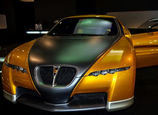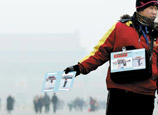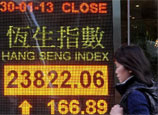
SHANGHAI, Jan. 30 (Xinhua) -- More measures to clean up the air are being considered by municipal departments of Chinese cities after netizens began to point the finger at the government over heavy smog.
There were calls for action over vehicle emission, which is allegedly a major contributor to the murky sky.
Xue Manzi, a Chinese start-up investor and prolific microblogger living in Beijing, said Wednesday on Sina Weibo that low-quality fuel is threatening people's lives. He called for immediate action to curb air pollution.
The latest round of smog on Tuesday hit a total of 1.3 million square kilometers across the country's central and eastern regions.
Beijing is shrouded in the fourth round of heavy smog that has hit the capital in four weeks.
This year, Shanghai, another megacity suffering from dense haze, will follow Beijing to implement a tighter National 5 vehicle emission standard, which is equivalent to Euro 5, according to Zhang Quan, director of the Shanghai Municipal Environmental Protection Bureau.
More than ten provinces including Guangdong, Zhejiang and Jiangsu adopted National 4 standard on Jan. 1, which is expected to reduce vehicle emission pollutants by 30 percent to 50 percent.
In addition to a stricter emission standard, some netizens said the government should keep the number of vehicles low, especially that of the official cars.
"I suggest that all the officials take public transportation as much as possible," said Sina Weibo user "Mengxiangchuanyueshiguang."
Beijing, along with Jinan city in Shandong Province and Shijiazhuang in Hebei Province, announced this week that some 30 percent of official cars in these cities will be suspended from running in cases of heavy smog.
In addition, Shanghai is considering a draft to compulsory suspend official vehicles when the Air Quality Index (AQI) reaches 301 and above, according to Zhang.
The draft also aims to control air pollutants from factories and construction sites, Zhang said.
Wang Rong, a senior municipal official from Shenzhen in south China's Guangdong Province, replaced his gasoline-powered official car with an electric one earlier this month.
More Shenzhen officials will use electric cars in the future, said Xu Qin, the mayor of the city.
However, there are concerns that the effects of airflow will carry pollutants to neighboring areas as smoggy weather disturbs more and more cities.
"Nearby regions contribute to 30 percent to 60 percent of Beijing's smog. What we need is joint efforts by cities and provinces," said Sina Weibo user "Xiaoxiaotang'er."
Zhou Shengxian, China's environment minister, said last Thursday that the ministry is considering setting up a trans-regional work team consisting of various provincial departments to cope with the haze in the Beijing-Tianjin-Hebei area as well as the Yangtze River Delta.
Vice minister Wu Xiaoqing also said that the ministry will help to revise the existing laws and regulations related to air pollution, emphasizing that legislation will be a key solution to the problem.
"What we need is not only a new act or revision, but firm implementation," said netizen "Amindejianghu" on Sina Weibo.
















 China uses PM 2.5 in weather alert system
China uses PM 2.5 in weather alert system


![]()
